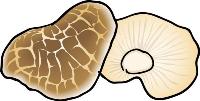Adaptation
HOW HAS GANODERMA APPLANATUM ADAPTED TO SURVIVE IN A HABITAT?
Fungus has adapted in many ways! They are immotile and do not use photosynthesis as a means of acquiring nutrients; so how in the world does this organism survive? Luckily, fungi have hyphae, which no other kingdom has. Hyphae help acquire nutrients by increasing surface area; this makes feeding more efficient because the fungus is able to absorb more nutrients. This is an adaptation if I have ever heard of one. Now, think about what a typical “mushroom” looks like; that picture would probably include a stalk. In this case, that is false; Ganoderma applanatum has adapted by growing from a host instead, which is another adaptation. So because Ganoderma applanatum does not have a stalk, it has to grow off something, right? It has adapted to living on trees. This specific species does NOT have gills. It is indeed a polypore, which is shown in the picture above. This species no longer has gills because of a constraint within the environment and more possibly, genetics. Because of the environments they live in, gills were not needed to increase surface area. Instead, Ganoderma applanatum grows on trees and increases surface area via growing INTO the tree. Therefore, gills are not a necessity. Also, because these brackets are elevated above the ground, spores depend on wind dissemination for releasing and spreading spores; pores are better for releasing spores to be carried off by wind. There are only a few adaptations listed here; note there are other ones missing.
HOW DOES GANODERMA APPLANATUM MOVE?
Unfortunately, Ganoderma applanatum is immotile. Because they are immotile, they have adapted to survive in specific habitats where movement is not necessary. This fungus grows on trees and has adapted in specific ways (listed above) to survive.
DOES GANODERMA APPLANATUM HAVE SENSES?
In my research, I have not found this fungus to have senses or specific reactions to environmental stimuli. They do grow to increase surface area, but that is not a sensory task or reaction to environmental stimuli. This is just an adaptation they have made in order to thrive in their habitats. I DID however learn in my BIO 203 lecture that fungal species react to light, which is an environmental stimuli. When the hyphae detect light, this triggers them to release spores or sporulate. The mechanism used to identify light is unknown.
HOW DOES THE STRUCTURE OF GANODERMA APPLANATUM RELATE TO THE FUCNTION OF THE FUNGUS?
The structure of this fungus is very related to the function. Ganoderma applanatum has mycelium that grow into the tree. The tree is their food source. This is how they increase surface area and absorb nutrients at the same time. So OF COURSE, their structure is very much related to the function of the fungus.
NEXT PAGE = NUTRITION
 Artist's Conk (Ganoderma applanatum)
Artist's Conk (Ganoderma applanatum).jpg)